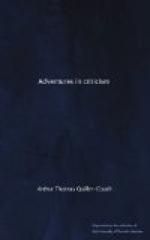“Here and there along the street Grocery Stores and shops of Italian Warehousemen may be observed, opened here as branches of bigger establishments in the City. Three gilt balls may occasionally be seen hanging out under the first-floor windows of a ‘pawnbroker’s’ residence. House-agents, too, are not uncommon along the line of route.
“The appearance of a winkle, when extracted from its shell with the aid of a pin, is extremely curious. There is a winkle-stall by the South Kensington Station of the Underground Railway. Underneath the stall the pavement is strewn with shells, where they have fallen and continue to lie. Close to the stall is a cab-stand, paved with a few cobbles, lest the road be worn overmuch by the restless trampling of cab-horses, who stand here because it is a cab-stand. The thick woollen goods which appear in the haberdashers’ windows through the winter—generally inside the plate glass—give way to garments of a lighter texture as the summer advances, and are put away or exhibited at decreased prices. But collars continue to be shown, quite white and circular in form; they will probably remain, turning grey as the dust settles on them, until they are sold.”
This is no travesty. It is a hasty, but I believe a pretty exact application of Jefferies’ method. And I ask how it would look in a book. If the critics really enjoy, as they profess to, all this trivial country lore, why on earth don’t they come into the fresh air and find it out for themselves? There is no imperative call for their presence in London. Ink will stain paper in the country as well as in town, and the Post will convey their articles to their editors. As it is, they do but overheat already overheated clubs. Mr. Henley has suggested concerning Jefferies’ works that
“in years to be, when the whole island is one vast congeries of streets, and the fox has gone down to the bustard and the dodo, and outside museums of comparative anatomy the weasel is not, and the badger has ceased from the face of the earth, it is not doubtful that the Gamekeeper and Wild Life and the Poacher—epitomising, as they will, the rural England of certain centuries before—will be serving as material authority for historical descriptions, historical novels, historical epics, historical pictures, and will be honoured as the most useful stuff of their kind in being.”
Let me add that the movement has begun. These books are already supplying the club-novelist with his open-air effects: and, therefore, the club-novelist worships them. From them he gathers that “wild apple-trees, too, are not uncommon in the hedges,” and straightway he informs the public of this wonder. But it is hard on the poor countryman who, for the benefit of a street-bred reading public, must cram his books with solemn recitals of his A, B, C, and impressive announcements that two and two make four and a hedge-sparrow’s egg is blue.




